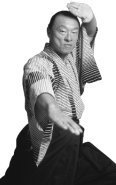The Martial Artist Athlete
January 1, 2007 admin 0 Comments
—
 While it may be true that still waters run deep, if Tagawa is any indication, fast waters run even deeper. Constantly in motion, and filled with seemingly boundless energy, Tagawa is a bottomless well of ideas and philosophies. He is currently working on a project that combines two of his deepest passions – martial arts and sports – into an integrated discipline.
While it may be true that still waters run deep, if Tagawa is any indication, fast waters run even deeper. Constantly in motion, and filled with seemingly boundless energy, Tagawa is a bottomless well of ideas and philosophies. He is currently working on a project that combines two of his deepest passions – martial arts and sports – into an integrated discipline.
While the two might seem to only be superficially related, Tagawa has drawn numerous parallels that are not intuitively obvious until they are pointed out – then they seem to be naturally related. Currently working on his first book, The Martial Artist Athlete, which will soon be available on-line at his Web site, www.caryhiroyukitagawa.com, Tagawa seems poised to revolutionize the world of martial arts and sports by combining the positive elements of both into a complete spiritual and athletic system of “total performance.”
Q: What is the current state of martial arts and sports?
A: I think that martial arts and sports have peaked, simply because we’ve come so far from the original intention of both. Martial arts was always passed as a gift of heaven, really, for the underdogs. However, it came to America as a sport rather than as an art, because of the emphasis of judo and karate tournaments after the World War II by Kano and the Funakoshi. So the budo was lost in the United States, or rather never known, except very indirectly. Traditional values, in general, were never part of the American martial arts culture – martial arts was just another sport.
I think the difference between martial arts and sports, is that in sports you don’t necessarily need respect. Sport doesn’t necessarily build character. Although they say it does, you don’t necessarily have to have character to play sports. So martial arts, when it emphasizes sports, becomes martial sports, rather than martial arts. Sports have also been contaminated. The original Olympics, for example, had very high ideals about sportsmanship. It was about the purity of the body itself and what the body represented. The original Olympians would be horrified to find what we’re doing to the body with drugs, and with today’s win-at-all-costs attitude. That same attitude, when it got applied to martial arts, was why I got disinterested.
Q: At what point did this happen?
A: I lost interest in martial arts when they became so heavily competition oriented. I was always more focused on the internal aspects and the respect – the traditional things that taught character though actions. You’re lucky today if you get any of that in modern martial arts. We’ve allowed martial arts to become a business, not a way of life. And any time you add business to an art, it’s over. So I left martial arts and started developing my own style – chuu-shin.
Q: What about sports?
A: I lost interest in sports when NFL football coaches started paying bounties for players to hurt other players. You could see very clearly that it was no longer about the love of the game, or about sportsmanship. It was about business and about how to eliminate the star athletes. The strategies in sports also went downhill in basketball, when coaches stalled in games in order to protect leads against better teams. Where’s the honor is winning that way?
So I think we’ve not only lost honor for the game, but also honor for ourselves as athletes. The samurai aspect of honoring your opponent is gone. Your opponent is not the enemy. This is not war – this is competition. We have such a need to define ourselves as winners and losers that we’ve lost the sense of respect for ourselves and others. You can’t respect other people unless you respect yourself.
Q: So you feel spiritual aspects apply to sports as well as martial arts?
A: Absolutely. The Olympics started as a way for soldiers to stay fit between wars. So it still had a war-oriented purpose. But it was a substitute for war – an outlet for aggression.
Martial arts, on the other hand, trained for war not sport. It’s about protecting yourself and, at worse, killing people. There are three different types of martial artists: the martial artist who has trained in the dojo and has traditional respect and honor; the martial artist who is into it for the flash – the Hollywood influence – the trophies – and only goes to tournaments for money; and the martial artists who train in the military and have actually killed people with their hands. I see those three levels as being very distinct and different.
Q: Where did the samurai fit in?
A: Theoretically, the samurai way is based on selflessness – they gave their life for their lord. But it’s not truly selfless in that they wanted to die honorably so they didn’t bring shame to their family name. The family name actually gains honor from the samurai’s death. So there is some self-interest there. And what if their lord was an jerk? They wasted themselves for nothing. That’s what actually happened sometimes. A lot of the samurai ended up dying for very little purpose which left only the wimps and the businessmen to carry on the tradition.
That is what makes the nature of the samurai and the ninja very different. The ninja actually started as priests who came from China – mountain priests who eventually degraded into just paid assassins. But at the highest level, when ninjitsu started, the roots are in a mountain warrior called the yamabushi. So the ninja were not so much about killing and dying as they were about getting the job done. The highest form of what they did was to get in and get out without anyone knowing they had been there. In that sense, given the difference of dying for a purpose and living for a purpose, I choose living for a purpose. But these principles are very foreign to the Western mentality. Everything in Western society is about displaying your manhood as an identity, rather than just being the manhood, which I believe the spiritual Asian energies are based on.
Q: So do you believe there’s a way to merge sportive Western thought and Eastern spiritual principles?
A: Yes, which is to go back to that sense of sportsmanship – the respect for your body, and the respect for your opponent. Your opponent is just a person who’s perfecting his art just as you’re perfecting your art. We’re talking about a meeting of two artists, basically. There’s no reason to think of him like a dog – to think that he is worthless. Martial arts should work to develop the internal sense that honors the spirit and the heart.
Q: Does your training system do this?
A: The whole art of chuu shin was developed without the concepts of competition and fighting. The art, using the staff, is about centering and focusing – concentration without fighting. I’ve taken martial arts principles of how the physical body works and then worked it into a physical training system for athletes without the fighting.
In sports today, the most used training concepts are aerobics, weight-lifting, and cross-training. Those three levels of training are about to be replaced. I say replaced because actually the system that does this will be called Mu Training and will come from Mu Sports. But Mu Training, which is an evolutionary step even above chu shinn, involves using water as a medium.
Centering is the key part of any physical activity, whether it be training or actual competition. Centering is the art of using energy rather than muscle. In the West we train muscles to create power and strength. In martial arts, the true force comes from the breath, or the ki, and involves resistance against gravity through the repetition of forms, and centrifugal force from whipping the hips to create striking power. So this system of chuu-shin, and also Mu Training, is based on three things: breathing, gravity, and centrifugal force. So the body in relation to those three things is going to change the nature of training and change the nature of performance in athletes – physically and spiritually.
Q: How long have you been developing it?
A: Formally, since 1993. I’ve taken every sport and broken it down by watching their top athlete’s movements. For example, when I played basketball, we just used to shuffle our feet around and move sideways and go forward and backwards – very linearly. But what is needed is to get moving in a chaotic way, so you don’t move in just one direction – in basketball you don’t just go in one direction. No one has addressed that kind of physical movement. You don’t get that from just lifting weights or running or from an aerobics class. So chaos training applies to basketball, football, hockey, baseball, and soccer. In those sports you’re constantly in motion, having to constantly change direction.
Q: Is your training system available now?
A: It exists, and I’m training a few people, but I just haven’t put it out. What I say to the people I train is that I could teach you the fighting aspects of martial arts, but I’d much rather teach you the movement principles that relate directly to your sport. How to move like a martial artist in your chosen sport is much more applicable than how to fight, because if you get into a fight on the court you’re out of the game. We see that more and more – the fighting – and it’s ridiculous. It’s simply a result of not having the martial arts concentration and focus without the fighting. Every sport – basketball, baseball, tennis, whatever – has an application of this.
The one major thing that is lacking in sports is breathing – which is a martial arts specialty. The aerobic theory started in the ‘70s from Major Kubo of the Royal Canadian Air Force. He found that the fittest athletes were the most aerobically positive. So you have to build your body to move the longest, at its most efficient. But aerobic theory focused too much on the heart – the heart is only a pump – the generator that makes the power is actually the lungs. Humans have twenty-five-hundred square feet of lung capacity and only use ten to fifteen percent. An athlete increasing his lung capacity by 85 percent would be capable of astounding performance. When those guarding him are huffing and puffing, he’d just be getting warmed-up.
Breathing is a whole new energy source that Western athletes haven’t considered. In a hundred meter race, for example, a sprinter has expended their oxygen by the forty-meter mark. So they have to go sixty meters with no oxygen – no wonder they’re cramping. Cramped muscles are a lack of oxygen. If you breathe more you won’t cramp, if you don’t cramp your muscles will keep going longer. It’s the difference between the carbo-loading theory of filling up a fuel tank once, at the beginning of the race, or the chuu-shin theory of constantly adding gas as the race progresses, by breathing. You should actually be running faster at the end of the race than you were at the beginning. But in sports today, it’s all about energy declination. So these are all principles that have not been looked at. When I formally implement them they will fundamentally change training and athletic performance.
